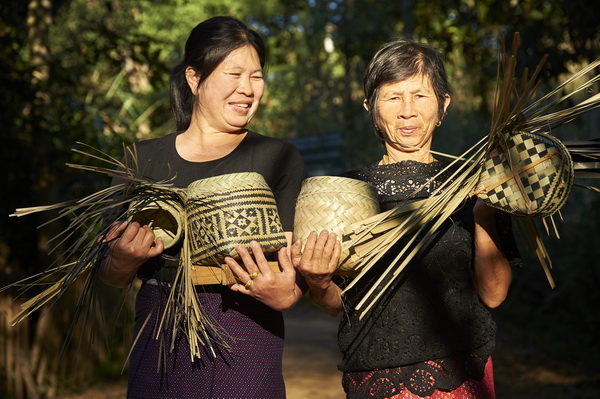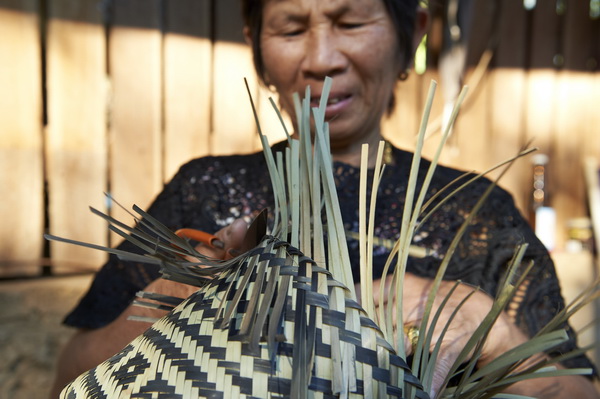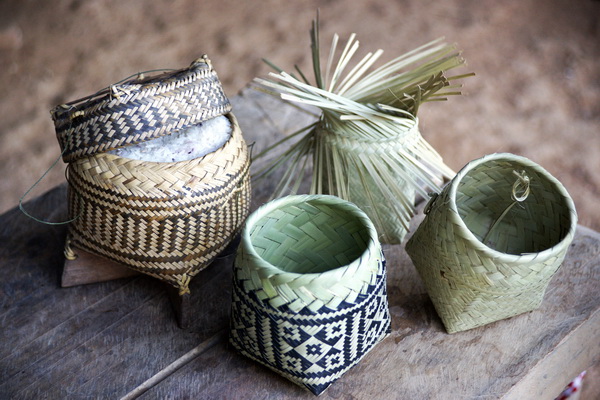Kong Khao Dok: Bamboo Rice Box (and Beyond)

[cr. Department of Cultural Promotion]
The sticky rice boxes painstakingly woven by village elders in a small Lampang community are as beautiful as they are practical.
Hands are constantly busy in the small village of Baan Pai Pong in Lampang Province’s Chae Hom District where the elders spend much of their leisure time weaving sticky rice boxes, not just for their own use but also to sell to visitors entranced by this simple but exquisite piece of art.
Known as “kong khao dok” (ก่องข้าวดอก), the sticky rice baskets are made of bamboo meticulously woven into a cylinder-shaped box with a removable cover. It’s not merely a hobby or even an income earner though; these village elders pick up the bamboo strips only when they have finished tending to their farms. Rice may be the main staple here but so too is creativity, with the rice boxes reflecting the practicality of weaving what they need as well as their wisdom.
While the Northeasterners call this sticky rice box “kratip,” (กระติ๊บ), pronounced kra-tip], people in the North of Thailand where Lampang Province is situated call their meticulous piece of art “kong khao,” which literally translates as rice box. And contrary to the Northeastern kratip, which is made of natural plain bamboo without a pattern, the sticky rice bamboo boxes woven by the elders of this village in Lampang’s Muang Mai Sub-District are full of colour and stylized patterns.
People here have been weaving bamboo into sticky rice boxes for their own households for more than a century. Their ancestors, the Chae, settled on the plains in this area known as Chae Hom, which later became the district’s name. With weaving techniques passed down from generation to generation, the sticky rice bamboo box of Baan Pai Pong is unique in its intricate patterns, which are achieved by the use of smaller strips of bamboo. This means the box can be shaped into eclectic shapes and forms as evidenced in the “kong khao kor kiew” and “kong khao kor learng” baskets, which boast a thinner mouth to trap the heat and steam from the warm sticky rice and keep it soft.

[cr. Department of Cultural Promotion]
The box itself is woven in two layers. For the innermost layer, the bamboo is woven with more space between the strips so that the steam from the sticky rice inside can flow into the gap between the innermost and the outermost layers. The outer layer meanwhile is meticulously and tightly woven to prevent steam from leaking out. The technique applied to this craft allows for the sticky rice inside will keep warm, while preventing too much moisture from being trapped and turning the rice it soggy.
Baan Pai Pong’s sticky rice box also features ancient woven patterns with flower names, among them Chan Kiew, Chan Pad Kleep, Dok Kaew, Prachae Chine, Kam Ber and Kam Bee. Bamboo strips are dyed with natural colors derived from the barks of the Kram and Yi trees though these days, paint is also often used.
In 1881, a Norwegian naturalist named Carl Alfred Bock featured in his book Temples and Elephants: Travels in Siam in 1881-1882, a photo he had taken of a sticky rice box, identified by local people as “Kong Khao Dok Kam Buang Luang” (literally Rice Box of a flower named Kam Buang Luang). The photo shows a hand-made sticky rice box made with black-dyed bamboo woven into the shape of large spider. The container represents the art being transferred down through the generations, exuding not only sacred wisdom but also historical remnants of the ancient Northern land.
Today, Baan Pai Pong people continue to weave these hand-made sticky rice boxes as if time had stood still. Both the intricacy of the craft and its woven patterns have been transferred to other items such mats, bags and toys, which are eagerly snapped up by visitors from afar to remind them of the land they once visited.

[cr. Department of Cultural Promotion]
************************
Reference
Komalakul na Nakorn, Thakur. Kong Khao Dok Jak Tok Sen Sai Su Ngarn Silpa [Kong Khao Dok: The art of Thai basketry]. Watthanatham Journal: Department of Cultural Promotion, vol. 56, no. 2, April-June 2017, p. 26-33. Available at http://magazine.culture.go.th/2017/2/mobile/index.html#p=27.


